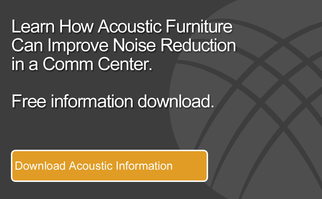 1. Why are acoustics important in a communications center?
1. Why are acoustics important in a communications center?
No one likes to unintentionally eavesdrop on colleagues’ conversations — whether it’s work-related or personal. But in some office environments, noise travel fast, allowing you to hear other employees’ voices and movements from across the room, whether you want to or not. These undesirable sounds not only affect employees’ productivity, but also decrease privacy.
A room that is considered “loud”, “reverberant”, or “echoey” generally needs additional sound-absorption solutions. Workplaces designed with acoustics in mind will help absorb, block and cover sound by utilizing a combination of products. While successful acoustical design won’t eliminate noise completely, it will lessen it, allowing comm center employees to work more efficiently and effectively.
2. What is NRC?
The Noise Reduction Coefficient (otherwise known as NRC) is a standard rating system for how well a material absorbs sound, quantified as a percentage. For example, a material with an NRC of .75 means that 75% of the sound energy that contacts that material is absorbed, and not reflected back into the room. Materials with an NRC rating of .75 or higher are generally considered highly absorptive and will yield the greatest improvement with the least amount of material.
While NRC is often thought to be a figure used only for rating acoustic products — like wall paneling, ceiling tiles or floor coverings — in reality, every material in our environment has an impact on acoustics, and can be tested for an NRC rating.
3. What are some products that can help decrease office noise?
We’re glad you asked! There are several solutions to help reduce the sound in a work environment. Here are a few common acoustical items to consider for your comm center:
-
Ceiling Tiles
Typical “acoustic” ceiling tiles have an NRC of .55 to .65 or less. These materials alone are often insufficient for achieving good acoustic conditions in the workplace. High-NRC ceiling tiles (.75 or higher) offer significantly better absorption for spaces where acoustics are important.
-
Workstations and Consoles
Choosing furniture solutions that offer a high acoustic value panel system will prevent noise reverberation by stopping it at the source. When looking at panel acoustical materials stay away from those made from steel and sheet metal, which are some of the loudest substances on the market. Try to imagine a music studio, enveloped in thick, acoustical foam. While this might not be the most visually appealing option for a workspace, there are many other types of wall and cubicle panels that are specifically designed to absorb sound and stop it from reverberating around the office.
If possible, opt for soft-close drawers, which can also cut back on the clamor.
-
Floor Coverings and Drapes
Standard carpeting and drapes are often thought to be good sound absorbers, but surprisingly many of these materials have an NRC of .35 or less. A “boomy” room will never be fixed by adding carpet and or drapes alone (although it does help). All these elements — consoles, carpet, ceiling tiles, paneling, drapes — must work together to provide an acoustical-balanced space.
4. How is a quieter work environment beneficial to employees?
Noise (defined as unwanted sound) is a big concern for comm center managers. Research has shown that poorly designed acoustics in work environments can decrease productivity, lower work quality, elevate stress levels and increase employee dissatisfaction. With this in mind, it’s imperative that a comm center strikes a balance between fostering conversation and preventing over communication — where employees can’t help but hear what’s going on around them.
Proper acoustical design can help by alleviating disruptive sounds without turning the office silent. The physical and psychological benefit to employees will be well worth it!



